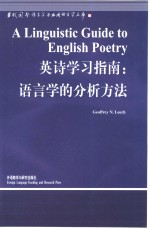

英诗学习指南 语言学的分析方法 英文版PDF电子书下载
- 电子书积分:10 积分如何计算积分?
- 作 者:(英)Geoffrey N.Leech著;秦秀白导读
- 出 版 社:北京:外语教学与研究出版社
- 出版年份:2001
- ISBN:7560024297
- 页数:249 页
INTRODUCTION 1
0.1 The ‘lang.-lit.’problem 1
0.2 A descriptive rhetoric 3
0.3 Poetic language and ‘ordinary’language 5
0.4 A possible misgiving 6
Notes 7
1.1 Varieties of English usage 8
1.1.1 Dialects 8
1 POETRY AND THE LANGUAGE OF PAST AND PRESENT 8
1.1.2 Registers: usage according to situation 9
Preface by Halliday F 12
1.2 Linguistic convention in poetry 12
王宗炎序 F 13
1.2.1 The trend of conformity 13
1.2.2 The function of archaism 14
1.2.3 Poetic language and poetical language 15
Preface by Chomsky F 16
1.2.4 Grand, middle, and plain styles 16
1.2.5 The routine licences of verse composition 17
Examples for discussion 19
Notes 22
沈家煊序 F 23
2 THE CREATIVB USE OF LANGUAGB 23
2.1 The escape from banality 23
2.2 Two meanings of creative 24
2.3 The qualities of prose in poetry 25
导读 F 26
2.4 Degrees of linguistic audacity 29
Examples for discussion 33
Notes 35
3 VARIETIES OF POETIC LICENCE 36
3.1 Anatomy of language 37
3.1.1 Three main levels: realization, form, semantics 37
Foreword F 37
3.1.2 Phonology and graphology 39
3.1.3 Meaning and significance 39
Preface F 39
3.1.4 Ancillary branches of linguistics 40
Acknowledgments F 41
3.2 Types of deviation 42
3.2.1 Lexical deviation 42
3.2.2 Grammatical deviation 44
3.2.3 Phonological deviation 46
3.2.4 Graphological deviation 47
3.2.5 Semantic deviation 48
3.2.6 Dialectal deviation 49
3.2.7 Deviation of register 49
3.2.8 Deviation of historical period 51
3.3 Conclusion 52
Examples for discussion 53
Notes 54
4 FOREGROUNDING AND INTERPRETATION 56
4.1 Foregrounding 56
4.1.1 Foregrounding in art and elsewhere 56
4.2 Interpretation 58
4.1.2 An example 58
4.2.1 The subjectivity of interpretation 59
4.2.2 The warranty for a deviation 61
4.3 Parallelism 62
4.3.1 Parallelism as foregrounded regularity 62
4.3.2 How much regularity? 64
4.3.3 Patterns of identity and contrast 65
4.3.4 The interpretation of parallelism 67
Examples for discussion 69
Notes 71
5 VERBAL REPETTTION 73
5.1 Schemes and tropes 74
5.2 Formal repetitions 76
5.2.1 Free verbal repetition 77
5.2.2 Types of verbal parallelism 79
5.2.3 The functions of verbal parallelism 84
Examples for discussion 86
Notes 88
6 PATTERNS OF SOUND 89
6.1 Sound patterns within syllables 89
6.2 Sound patterns in relation to stress 91
6.3 Music in poetry 93
6.4 The interpretation of sound patterns 95
6.4.1 Chiming 95
6.4.2 Onomatopoeia 96
6.4.3 Varieties of onomatopoeia 97
Examples for discussion 100
Notes 102
7 METRE 103
7.1 Rhythm and metre 103
7.2 The rhythm of English 104
7.2.1 The measure: the unit of rhythm 106
7.2.3 Pauses 107
7.2.2 Which syllables are stressed? 107
7.2.4 Syllable length 108
7.3 Metre and the line of verse 111
7.3.1 English metre as rhythmic parallelism 111
7.3.2 The foot of traditional prosody 112
7.3.3 The line of verse 114
7.3.4 Some numerical aspects of metre 115
7.3.5 Accentual metre 118
7.4 The interaction of rhythm and verse form 119
7.4.1 Defeated expectancy 119
7.4.2 Metrical variation 121
7.5 Grammar and metre 122
7.5.1 Enjambment 123
7.5.2 The verse paragraph 125
For discussion 128
Notes 128
8 THE IRRATIONAL IN POETRY 131
8.1 A logical view of meaning 131
8.1.1 Some types of semantic oddity 131
8.1.2 Definition and description 134
8.2 Redundancy in poetry 136
8.2.2 Tautology 137
8.2.1 Pleonasm 137
8.2.3 Periphrasis 138
8.3 Absurdity in poetry 140
8.3.1 Oxymoron 140
8.3.2 Paradox 142
8.4 Beyond reason and credibility 143
Examples for discussion 144
Notes 146
9 FIGURATIVB LANGUAGB 147
9.1 Transference of meaning 148
9.1.2 Metaphor 150
9.1.1 Synecdoche 150
9.1.3 Metonymy 152
9.2 Aspects of metaphor 153
9.2.1 How to analyse a metaphor 153
9.2.2 Simile and metaphor 156
9.2.3 Notional classes of metaphor 158
9.2.4 Extended metaphor 159
9.2.5 Compound metaphor and mixed metaphor 159
9.2.6 Symbolism and allegory 161
Examples for discussion 164
Notes 165
10 HONEST DECBPTIONS 166
10.1 Hyperbole and litotes 167
10.1.1 Hyperbole 167
10.1.2 Litotes or rhetorical understatement 168
10.1.3 The uses of hyperbole and litotes 170
10.2 Irony 171
10.2.1 The mask of irony 171
10.2.2 Irony and metaphor 173
10.2.3 Innuendo 174
10.2.4 Irony of tone 176
Examples for discussion 179
Notes 182
11 IMPLICATIONS OF CONTEXT 183
11.1 Licences of situation 184
11.1.1 Rhetorical question 184
11.1.2 Apostrophe 185
11.1.3 Routine licences of situation 186
11.2 The given situation 187
11.3 The world within the poem 189
11.3.1 The introduction of inferred situations 191
11.3.2 Words of definite meaning 193
11.3.3 Fact and fiction 195
11.3.4 Impossible situations 197
11.4 Situation and action 199
11.5 Conclusion 201
Examples for discussion 202
Notes 204
12 AMBIGUITY AND INDBTERMINACY 205
12.1 Kinds of ambiguity 205
12.2 Puns and word-play 209
12.2.1 Technical variations 210
12.2.2 In defence of the pun 212
12.3 Open interpretation 214
12.3.1 Sources of multiple and indeterminate significance 215
12.3.2 The analogy of visual arts 217
12.3.3 Seeking the optimal interpretation 220
Examples for discussion 221
Notes 223
CONCLUSION 225
Notes 227
Suggestions for Further Reading 229
General Index 233
Index of Sources of Examples for Discussion 239
文库索引 241
- 《卓有成效的管理者 中英文双语版》(美)彼得·德鲁克许是祥译;那国毅审校 2019
- 《阅读指要》陈艺鸣编著 2020
- 《程序逻辑及C语言编程》卢卫中,杨丽芳主编 2019
- 《幼儿园课程资源丛书 幼儿园语言教育资源》周兢编 2015
- 《AutoCAD 2018自学视频教程 标准版 中文版》CAD/CAM/CAE技术联盟 2019
- 《跟孩子一起看图学英文》张紫颖著 2019
- 《高等学校“十三五”规划教材 C语言程序设计》翟玉峰责任编辑;(中国)李聪,曾志华,江伟 2019
- 《AutoCAD机械设计实例精解 2019中文版》北京兆迪科技有限公司编著 2019
- 《音乐语言的根基》张艺编著 2019
- 《宋微宗瘦金书千字文临摹指要》邱金生 2018
- 《中风偏瘫 脑萎缩 痴呆 最新治疗原则与方法》孙作东著 2004
- 《水面舰艇编队作战运筹分析》谭安胜著 2009
- 《王蒙文集 新版 35 评点《红楼梦》 上》王蒙著 2020
- 《TED说话的力量 世界优秀演讲者的口才秘诀》(坦桑)阿卡什·P.卡里亚著 2019
- 《燕堂夜话》蒋忠和著 2019
- 《经久》静水边著 2019
- 《魔法销售台词》(美)埃尔默·惠勒著 2019
- 《微表情密码》(波)卡西亚·韦佐夫斯基,(波)帕特里克·韦佐夫斯基著 2019
- 《看书琐记与作文秘诀》鲁迅著 2019
- 《酒国》莫言著 2019
